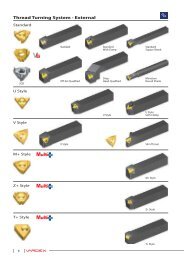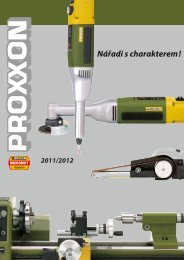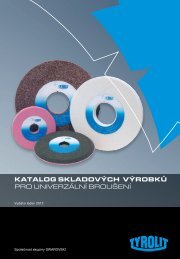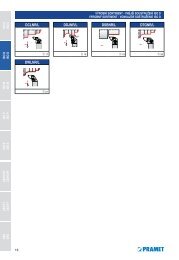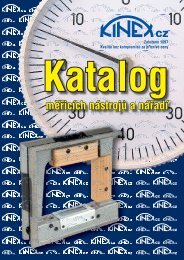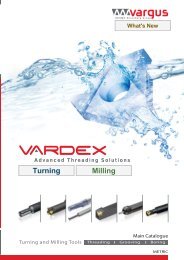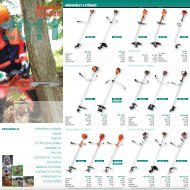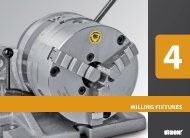Norton Industrial Catalog 7362 2011.indd
Norton Industrial Catalog 7362 2011.indd
Norton Industrial Catalog 7362 2011.indd
Create successful ePaper yourself
Turn your PDF publications into a flip-book with our unique Google optimized e-Paper software.
TOOLROOM CUT-OFF WHEELS<br />
CATEGORY DEFINITION<br />
Reinforced and non-reinforced engineered cut-off wheels for cutting all types of tool steel<br />
with fixed-based cut-off machines.<br />
APPLICATIONS:<br />
SIZE RANGE:<br />
GRIT RANGE:<br />
ABRASIVE GRAIN:<br />
BOND:<br />
SHAPE:<br />
Reinforced cut-off wheels are designed to resist breakage caused by<br />
severe cross-bending and are required on any operation where the<br />
work is not securely clamped.<br />
Non-Reinforced cut-off wheels are designed for use on fixed-based<br />
machines where the work is securely clamped, guarded, and<br />
where the wheel operates on a controlled cutting plane.<br />
6" – 12" diameter<br />
36 – 90 grit<br />
Aluminum Oxide<br />
Resinoid, Rubber, and Shellac<br />
Type 01 Straight<br />
CROSS REFERENCE GUIDE<br />
BETTER<br />
Reinforced Reinforced Non-Reinforced<br />
A60-OBNA2 57A364-TB25N 57A60-M8B<br />
Bates A602-T-BF A36-R-BF -<br />
Buffalo A60-R-BF2 - -<br />
Dia. Tool A80-SP A46-SP -<br />
Radiac A54-N6-B20 - A54-N6-B20<br />
Tyrolit A60-QBF38A2 - -<br />
• Smooth side pattern – Used when a precise thickness tolerance<br />
is needed<br />
• Rough (R) sides pattern – Abrasive particles protrude from<br />
sides of wheel; used wet or dry on most metals<br />
TROUBLESHOOTING GUIDE<br />
PROBLEM POSSIBLE CAUSES SUGGESTED CORRECTION<br />
Poor cut rate Insufficient power used Increase feed or pressure to full power<br />
Wheel too hard<br />
Use softer grade, or thinner wheel<br />
Contact area too large<br />
Reduce contact area<br />
Wheel too coarse<br />
Use finer grit<br />
Wheel side out of truth<br />
Check spindle runout<br />
Non-square cuts Work not clamped properly Check clamp and clean to remove swarf<br />
Misaligned spindle bearings<br />
Check for bearing truth and alignment<br />
Poor coolant distribution<br />
Ensure equal volume of coolant to each wheel side<br />
Wheel is too hard<br />
Use softer acting wheel: softer grade, or finer grit<br />
Workpiece burn Insufficient feed rate Work machine to maximum power available<br />
Poor coolant flow<br />
Increase volume and direct at cutting point<br />
Wheel is too coarse<br />
Use finer grit or more machine power<br />
Wheel is too hard<br />
Use softer grade wheel<br />
Wheel is running out<br />
Check spindle and flanges<br />
Wheel speed is too slow<br />
Ensure tight flanges and maximum safe operating speed being used<br />
Poor finish Too much burr Use finer grit, or softer grade<br />
Wheel too coarse<br />
Use finer grit<br />
• Wheels with a “W” reinforcement (reinforcement around the hole) are not considered to be truly reinforced.<br />
• Clamp or fixture the workpiece for straightest cuts<br />
• Run wheels at the highest possible speed marked on the wheel and make cuts as quickly as possible. Do not overspeed wheels.<br />
• It is recommended that a cut-off machine should have 1 horsepower for every inch of wheel diameter. For less than this, we recommend using a<br />
softer specification.<br />
• Using a harder grade wheel increases wheel life, but it also increases burn, power required and decreases cut rate.<br />
• Using a coarser grit wheel increases wheel life and cut rate, but it also increases burr and power required.<br />
34 NORTON – THE MUSCLE BEHIND THE MACHINE



